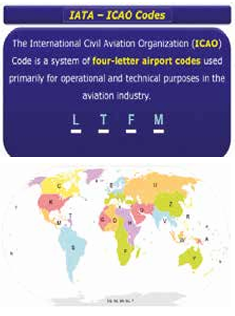
The codes we encounter in avIatIon
Most of the time, we encounter many different codes in our air travels without realizing it. For example, TK1637, TC-JDJ, LAX airport, etc. ICAO (International Civil Aviation Organization) and IATA (International Air Transport Association) have made some arrangements regarding the codes used in aviation.
They have tried to create a standard approach by making some arrangements regarding the names of airports, countries, airline companies and aircraft models etc… However, there are some differences in the systematics created by these two organizations.
The difference between IATA and ICAO
Both IATA and ICAO are international organizations that oversee civil aviation operations. However, the IATA generally supports the airline industry, while the ICAO provides global standards for air transport operations.
IATA and ICAO use some codes for airports, airlines and countries.

ICAO codes versus IATA codes for Airports.
In general IATA codes are usually derived from the name of the airport or the city it serves, while ICAO codes are distributed by region and country.
The International Civil Aviation Organization (ICAO) Code is a system of four-letter airport codes used primarily for operational and technical purposes in the aviation industry and as stated above ICAO codes are distributed by region and country. So, each region and the country in this region has a specific code. For example, Türkiye is in Europe which has a code “L” and has its own code such as “T”, and finally “LT”.
IATA (International Air Transport Association) code is a system of four-letter airport codes.
The ICAO airport code or location indicator is a four-letter code designating aerodromes around the world. These codes, as defined by the International Civil Aviation Organization and published in ICAO Document 7910: Location Indicators, are used by air traffic control and airline operations such as flight planning.
ICAO codes are also used to identify other aviation facilities such as weather stations, international flight service stations or area control centers, whether or not they are located at airports. Flight information regions are also identified by a unique ICAO-code.
ICAO codes are separate and different from IATA codes, which are generally used for airline timetables, reservations, and baggage tags. For example, the IATA code for London’s Heathrow Airport is LHR and its ICAO code is EGLL. ICAO codes are commonly seen by passengers and the general public on flight-tracking services such as FlightAware.
In general IATA codes are usually derived from the name of the airport or the city it serves, while ICAO codes are distributed by region and country. Far more aerodromes (in the broad sense) have ICAO codes than IATA codes, which are sometimes assigned to railway stations as well. Selection of ICAO codes is partly delegated to authorities in each country, while IATA codes which have no geographic structure must be decided centrally by IATA.
While IATA codes specifically support the airline travel industry, ICAO codes more broadly support international flight operations regardless of the type of operation (to include general and business aviation)
Airline codes
IATA assigns a unique two-character code (Airline Designator Code) to all airlines – even the ones that aren’t IATA members. It consists of 2 letters or a letter and a digit. For example, AA stands for American Airlines, KL for KLM, 7S for Ryan Air, TK for Turkish Airlines etc. ICAO assigns a unique three-character code such as THY for Turkish Airlines. Flight numbers are usually given by IATA codes. TK1637, AA49, LH408, AF158 etc…


Country codes
Country codes are same in both ICAO and IATA. Each country has a specific code for example Türkiye has the code “TC” in both IATA and ICAO. USA has the code “N”, France “F” etc…